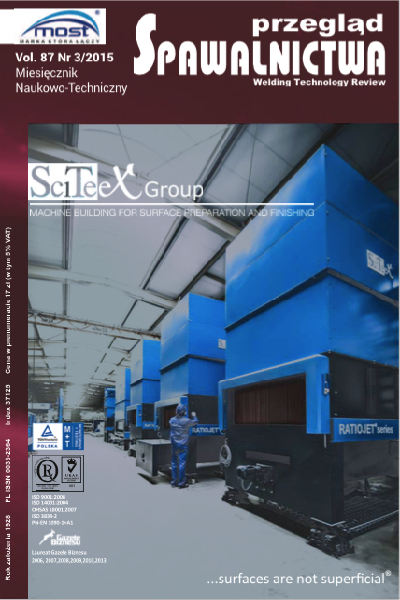Nowe możliwości wytwarzania powłokowych barier cieplnych metodą natryskiwania plazmowego z zawiesin
##plugins.themes.bootstrap3.article.main##
Abstrakt
Powłokowe bariery cieplne (Thermal. Barrier. Coatings) są zaawansowanymi systemami materiałowymi, których głównych zadaniem jest ochrona powierzchni metalicznych, np. w turbinach lotniczych, przed obciążeniami cieplnymi. Jednym z najważniejszych elementów tego układu jest zewnętrzna powłoka ceramiczna, która ze względu na małą przewodność cieplną oraz wysoką temperaturę topnienia umożliwia obniżenie profilu temperatury na przekroju elementów do wartości dopuszczalnych przez pozostałe materiały. Kluczowym zagadnieniem pozostaje możliwość wytwarzania omawianych powłok w sposób ekonomiczny oraz jednocześnie przy zachowaniu korzystnej struktury powłok gwarantującej zachowanie odpowiednich właściwości użytkowych. W badaniach przeprowadzono złożony plan eksperymentu natryskiwania powłok z uwzględnieniem różnych zmiennych w procesie: (i) prędkości liniowej palnika, (ii) odległości natryskiwania, (iii) zawartości fazy stałej w zawiesinie oraz (iv) sposobu przygotowania podłoża. W procesie natryskiwania użyto zawiesin na bazie dwóch różnych proszków tlenku cyrkonu: częściowo, oraz w pełni, stabilizowanego tlenkiem itru; oba są obecnie powszechnie stosowane w przemyśle. Na podstawie przeprowadzonych badań ich mikrostruktury dokonano oceny, czy metoda natryskiwania plazmowego z zawiesin, w perspektywie kolejnych lat, może stanowić alternatywę dla obecnie używanych metod do wytwarzanie powłokowych barier cieplnych.
The new possibilities for the production of Thermal Barrier Coatings by Suspension Plasma Spraying
Abstract
Thermal Barrier Coatings are advanced multi-material systems whose main goal is to protect metallic surfaces against thermal loads, like for example blades in gas turbines. One of the most important elements of TBC system is the ceramic top layer. Due to the low thermal conductivity and a high melting point it allows reducing the temperature profile measured on the cross-section of the element below the limit values for all used materials. The key issue is the ability to produce coat- ings in an economical way and maintaining a microstruc- ture of coatings guaranteeing the preservation of proper properties at the same time. In the presented studies the complex spray process was conducted. Design of spray experiment was made taking into account the different variables in the process: (i) the linear speed of the torch, (ii) spraying distance, (iii) a solid content in the suspension, and (iv) way of preparing a substrate topography. Two different yttria stabilized zirconia powders were used to prepare suspensions: partially and fully stabilized respectively. These powders are now widely used in the industrial applications. Based on the microstructural studies an assessment was carried out if the Suspension Plasma Spraying can be an alternative method for the production of thermal barrier coatings to the processes applied currently.
Pobrania
##plugins.themes.bootstrap3.article.details##
Creative Commons CC BY 4.0 https://creativecommons.org/licenses/by/4.0/
Artykuły czasopisma Welding Technology Review (Przegląd Spawalnictwa) publikowane są w otwartym dostępie na licencji CC BY (licencja Creative Commons Uznanie autorstwa 4.0 Międzynarodowe). Licencja CC BY jest najbardziej otwartą dostępną licencją i uważaną za „złoty standard” w formule otwartego dostępu; jest również preferowany przez wielu fundatorów badań. Licencja ta umożliwia czytelnikom kopiowanie i redystrybucję materiału na dowolnym nośniku i w dowolnym formacie, a także zmienianie, przekształcanie lub budowanie na nim materiału, w tym do użytku komercyjnego, pod warunkiem wskazania oryginalnego autora.
Bibliografia
F.R. MartÃnez, A.A.R. MartÃnez, M.T. Velázquez, P.Q. Diez, G.T. Eslava, J.A. Francis: Evaluation of the Gas Turbine Inlet Temperature with Relation to the Excess Air, Energy and Power Engineering, 2011, 3, s. 517-524.
E. Campo, V. Lupinc: High Temperature Structural Materials for Gas Turbines, Conference of Innovative Materials, IMAT 92, Modena, 1992.
Roberts T.: The Structure and Stability of High Temperature Intermetallic Phases for Application within Coating Systems, PhD Thesis, Cranfield University, November 2009.
A.S. Khanna, S.K. Jha.: Degradation of materials under hot corrosion conditions, Trans. Indian Inst. Met. 51 (5) (1988) s. 279290.
H. Xu, H. Guo: Thermal barrier coatings, Woodhead Publishing Limited, 2011.
T.B. Hazel, D.A. Litton, M.J. Maloney, U.S. Patent No. US20130260132, 2013.
J. Larose, US Patent No. 2014/0017477 A1, 2014.
R.C. Reed: The superalloys: fundamentals and applications,
Cambridge University Press, UK, 2006.
G. Evans, D. Clarke, C. Levi: The influence of oxides
on the performance of advanced gas turbines, Journal
of the European Ceramic Society, 28 (2008), s. 1405-1419.
R. Swadźba, J. Wiedermann, R. Rozmus: Analiza mikrostruktury powłokowych barier cieplnych TBC po teście cyklicznego utleniania w temperaturze 1100 °C, Prace Instytutu Metalurgii Żelaza, 3 (2013), s. 29-34.
P. Nitin Padture, Maurice Gell, E.H. Jordan: Thermal Barrier
Coatings for Gas-Turbine Engine Applications, Science,
Vol. 296 Issue 5566, s. 280-284, 2002.
R.A. Miller: Current status of thermal barrier coatings
an overview, Surf. Coat. Technol., 30 (1987), s. 1-11.
M. Gell, G. Vaidyanathan, B. Barber, et al.: Mechanism of spallation in platinum aluminide/electron beam physical vapour deposited thermal barrier coatings, Metall. Trans., 30A (1999), s. 427-435.
D.J. Wortman, B.A. Nagaraj, E.C. Duderstadt: Thermal bar- rier coatings for gas turbine use, Mater. Sci. Eng. A, 121 (1989), s. 433-440.
Z. Tang, H. Kim, I. Yaroslavski, G. Masindo, Z. Celler, D. Ellsworth: Novel Thermal Barrier Coatings Produced by Axial Suspension Plasma Spray, Proceedings of International Thermal Spray Conference and Exposition, 2011, Hamburg, Germany.
D.J. Wortman, B.A. Nagaraj, E.C. Duderstadt: Thermal bar- rier coatings for gas turbine use, Mater. Sci. Eng. A, 121 (1989) 433440.
F. Gitzhofer, E. Bouyer, M.I. Boulos: Suspension plasma spraying, US Patent 5 609 921, 3 November 1997.
L. Łatka, A. Cattini, L. Pawłowski, S. Valette,B. Pateyron, J.P. Lecompte, R. Kumar, A. Denoirjean: Thermal diffusivity and conductivity of yttria stabilized zirconia coatings obtained by suspension plasma spraying, Surface and Coatings Technology, 208 (2012) s. 87-91.
P. Sokołowski, S. Kozerski, L. Pawłowski, A. Ambroziak: The key process parameters influencing formation of columnar microstructure in suspension plasma sprayed zirconia coatings, Surface and Coatings Technology, Volume 260, 2014, s. 97-106.
Kozerski S., Pawłowski L., Jaworski R., Roudet F., Petit F., Two zones microstructure of suspension plasma sprayed hydroxyapatite coatings, Surface and Coatings Technology, 204 (2010) 1380-1387.
S. Kozerski, L. Łatka, L. Pawłowski, F. Cernuschi, F. Petit, C. Pierlot, H. Podlesak, J.P.Laval: Preliminary studies on suspension plasma sprayed ZrO2 + 8 wt.% Y2O3 coatings, Journal of the European Ceramic Society, 31 (2011), s. 2089-2098.
